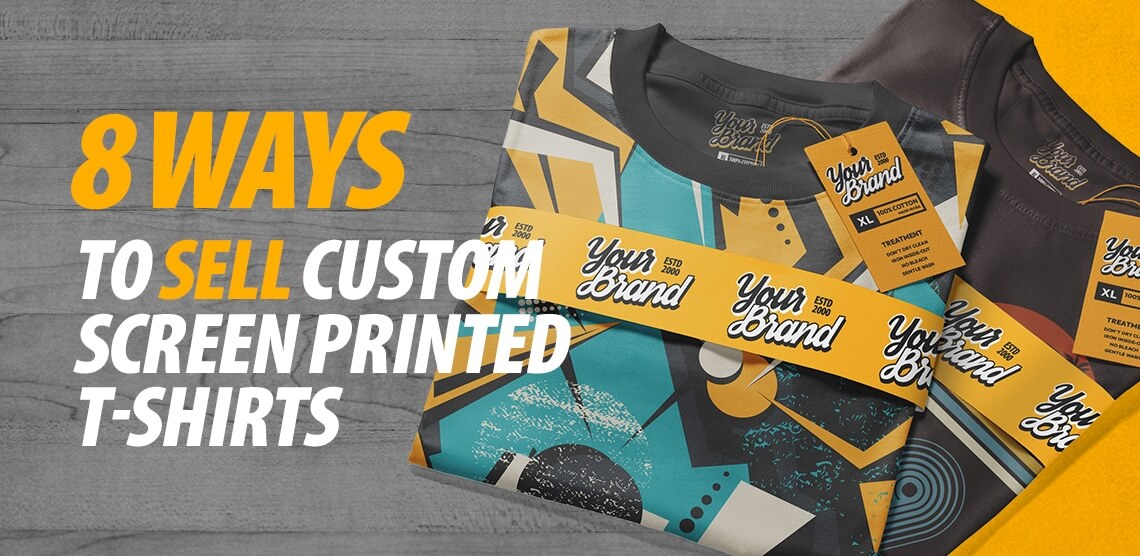Detailed Silk Screen Printing for Custom Art Apparel
Detailed Silk Screen Printing for Custom Art Apparel
Blog Article
Display Printing Uncovered: Whatever You Need to Find Out About T-Shirt and Garment Printing Techniques
Display printing is a fascinating technique that incorporates art with technique, providing unlimited opportunities for creativity. Prepared to check out the crucial components that make display publishing an art kind?
The Basics of Screen Printing: Just How It Works
When you dive right into screen printing, you'll uncover it's both an art and a scientific research. At its core, screen printing entails producing a stencil, or display, that allows ink to pass with only in specific locations (screen printing kit). You start by choosing your layout and preparing your screen with a light-sensitive solution. As soon as you subject this emulsion to light, it hardens, leaving your layout as an adverse area.
Next, you'll blend your inks and prepare your printing surface. Position the display over the textile, after that make use of a squeegee to push ink with the screen onto the garment. This procedure needs accuracy, as you want clear, lively prints. After printing, you'll heal the ink with warm, guaranteeing it follows the fabric and lasts with washes. Each action is essential, and understanding them will elevate your display printing abilities, transforming basic garments right into one-of-a-kind, expressive pieces.
Kinds of Display Printing Techniques
Once you comprehend the essentials of display printing, it's time to discover the various methods that can raise your styles. One preferred approach is traditional screen printing, where ink is pushed through a stenciled screen. This method is wonderful for bold, dynamic colors. There's water-based ink printing, which provides a softer feeling and is green, yet it calls for a various approach to curing.
If you're going for fine information, consider discharge printing. This strategy gets rid of color from the material, leaving a soft, vintage look. Another option is plastisol printing, known for its toughness and dazzling shades, making it a favored for several brand names. Ultimately, trying out halftone printing to develop slope impacts and detailed styles. Each method has its distinct beauty, so do not be reluctant to attempt them bent on discover what matches your design best!
Necessary Devices for Screen Printing
To attain stunning results in screen printing, having the appropriate equipment is basic. You'll require a durable screen printing structure, which holds the mesh that transfers your design onto the garment. Next, spend in top notch squeegees; these are important for applying ink equally across the screen.
Picking the Right Inks and Materials
When choosing inks and materials for screen printing, you require to take into consideration the kind of ink that functions ideal for your project. Think regarding fabric compatibility to ensure your layouts look wonderful and last long. Additionally, discover green ink choices to make your printing process more lasting.
Sorts Of Screen Inks
Choosing the right display ink is essential for attaining vivid, resilient prints that fulfill your job's demands. There are a number of kinds of screen inks to check out. Plastisol ink is popular for its versatility and ease of use, offering outstanding shade opacity on dark textiles. Water-based ink, on the various other hand, uses a softer feel and is green, making it excellent for those wanting to minimize their ecological impact. Discharge inks remove color from the textile, causing a soft, vintage appearance however call for certain handling. Specialty inks, such as metal or glow-in-the-dark, can include special effects to your layouts. Review your task demands and select the ink that straightens finest with your preferred result.

Textile Compatibility Factors To Consider
Understanding fabric compatibility is important for accomplishing top quality display prints, particularly because different products react uniquely to numerous inks. When selecting inks, consider the fabric type-- cotton, polyester, or blends. For cotton, water-based inks function well, using gentleness and breathability. Polyester, on the various other hand, usually calls for plastisol inks for far better bond and dynamic colors. You may require to utilize a mix of both kinds if you're printing on blends. Always test your inks on example material to assure they stick correctly and keep color honesty. Furthermore, keep in mind that textile weight and structure can affect the final outcome, so picking the best ink and product combo is vital for your task's success.
Eco-Friendly Ink Options
Eco-friendly inks are becoming a prominent selection for screen printers who desire to minimize their environmental influence while preserving quality. When picking inks, consider water-based inks, which are much less dangerous and simpler to cleanse up contrasted to standard solvents.
Additionally, look for inks made from renewable sources, such as soy or vegetable-based alternatives. By selecting the ideal inks and products, you'll not just produce stunning designs but also contribute to an extra lasting printing procedure. Make the button, and your prints will show your commitment to the environment!
Preparing Your Layout for Display Printing

Submit Layout Demands
To guarantee your layout looks sharp and dynamic on material, you'll right here require to pay attention to file layout requirements for screen printing. Beginning with vector files like AI or EPS, as they can be scaled without losing quality. If you make use of raster pictures, choose high-resolution data, such as TIFF or PNG, ideally at 300 DPI. Stay clear of using JPEGs, as they can lose quality when resized. Make certain your layout has a transparent history to avoid undesirable white sides on your prints. Finally, keep color modes in mind; CMYK is conventional for screen printing, so transform your RGB develops accordingly. By complying with these guidelines, you'll set your art work up for an effective print.
Color Separation Techniques
Shade separation is a crucial action in preparing your style for screen printing, and grasping it can substantially improve your print high quality. You'll need to break your layout into specific colors, as each shade needs a different screen throughout printing. This precision not just guarantees exact color depiction but likewise enhances the printing procedure.
Resolution and Size
Accomplishing the very best results in screen printing starts with assuring your layout has the ideal resolution and dimension. Ideally, your artwork ought to be at least 300 DPI (dots per inch) for sharp, clear prints. Your last item might look amateur and pixelated. if you make use of reduced resolution.
When it involves size, think about the dimensions of your print location. Style your art work to match the last print size, ideally producing it in the real dimensions you'll be publishing. By helpful resources doing this, you'll stay clear of any type of unexpected scaling issues.
Always examine your style in both vector and raster styles. Vector graphics can be scaled without shedding top quality, making them suitable for display printing. Preparing appropriately will guarantee your style looks remarkable on every garment!
Step-by-Step Display Printing Refine
Screen printing is a vibrant process that permits you to create dynamic designs on different surface areas. To begin, you'll need a display, emulsion, and your selected ink. Prepare your display by cleansing it completely. Next, apply the emulsion evenly and let it dry in a dark area. When completely dry, reveal your screen to light with your design put on it, which will harden the emulsion where the light hits, creating a pattern - screen printing kit.
After cleaning out the unexposed emulsion, your display is prepared. Set it up on your printing surface and straighten your garment under it. Put ink onto the display and utilize a squeegee to press the ink with the pattern onto the fabric. Lift the screen thoroughly and allow the print completely dry. Cure the ink using warmth to ensure durability. That's it! You have actually effectively screen published your style.
Tips for Successful Screen Printing Projects
While you're diving into your display printing jobs, bear in mind that prep work is vital to success. Begin by collecting all your materials-- inks, squeegees, garments, and screens. A tidy work space assists avoid undesirable errors, so clean up prior to you begin.
Following, confirm your artwork is high-resolution and properly sized for your garment. Evaluate your screen for proper exposure and tidy it extensively to avoid spots. When blending your inks, follow the maker's standards to achieve the right uniformity.
Throughout printing, apply even stress with your squeegee for regular outcomes. Do not rush; take your time to verify each print fulfills your standards. After printing, let your garments dry entirely before managing or packaging them.
Lastly, constantly keep an example of your work for future reference. In this manner, you can assess your development and boost your techniques in time. Satisfied printing!

Frequently Asked Concerns
For how long Does It Require To Set up a Screen Printing Work?
Establishing a display printing task normally takes around thirty minutes to an hour. You'll prepare the displays, mix inks, and adjust journalism. The time varies based upon intricacy and experience, so remain organized!
Can I Publish on Various Textile Keys In Using the Very Same Technique?
Yes, you can publish on different fabric types using the same strategy, but you'll need to readjust your setups and inks. Some fabrics soak up ink in different ways, so experimenting warranties the best results for each and every product.
What Are Common Blunders to Stay Clear Of in Screen Printing?
When display printing, avoid common errors like utilizing the wrong ink, neglecting correct direct exposure times, or avoiding pre-press checks. Always examine your arrangement and keep clean screens to guarantee top quality outcomes each time.
Just How Can I Effectively Clean and Maintain My Screen Printing Tools?
To effectively clean and preserve your display printing devices, you should on a regular basis wash displays with suitable solvents, examine squeegees for wear, and ensure all tools are kept dust-free and dry. Uniformity enhances and avoids pricey repair work efficiency.
Is Display Printing Eco-friendly Contrasted to Other Techniques?
Display printing can be a lot more eco-friendly than other techniques, especially if you make use of eco-conscious products and water-based inks. By picking lasting supplies and techniques, you decrease waste and decrease your impact on the planet.
Display Printing Uncovered: Every Little Thing You Need to Know About T-Shirt and Garment Printing Strategies
At its core, screen printing involves developing a stencil, or display, that enables ink to pass through just in specific areas. Placement the screen over the material, then utilize a squeegee to press ink with the display onto the garment. One popular method is standard display printing, where ink is pressed with a stenciled screen.When selecting inks and materials for display printing, you need to take right into account the kind of ink that functions best for your job.
Report this page